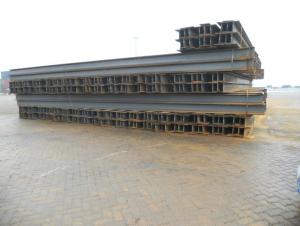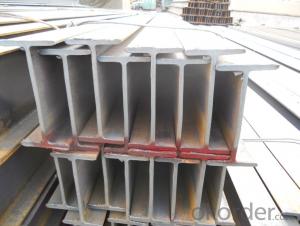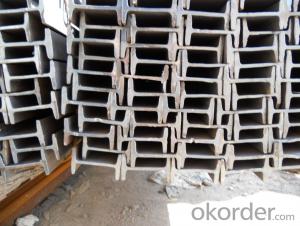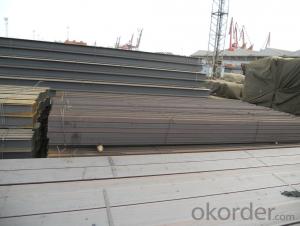Hot Rolled Structural Steel H Beam SS400
- Loading Port:
- Tianjin
- Payment Terms:
- TT or LC
- Min Order Qty:
- 100 m.t.
- Supply Capability:
- 100000 m.t./month
OKorder Service Pledge
OKorder Financial Service
You Might Also Like
Product Description:
OKorder is offering Hot Rolled Structural Steel H Beam SS400 at great prices with worldwide shipping. Our supplier is a world-class manufacturer of steel, with our products utilized the world over. OKorder annually supplies products to European, North American and Asian markets. We provide quotations within 24 hours of receiving an inquiry and guarantee competitive prices.
Product Applications:
Hot Rolled Structural Steel H Beam SS400 are ideal for structural applications and are widely used in the construction of buildings and bridges, and the manufacturing, petrochemical, and transportation industries.
Product Advantages:
OKorder's Hot Rolled Structural Steel H Beam SS400B are durable, strong, and resist corrosion.
Main Product Features:
· Premium quality
· Prompt delivery & seaworthy packing (30 days after receiving deposit)
· Corrosion resistance
· Can be recycled and reused
· Mill test certification
· Professional Service
· Competitive pricing
Product Description:
Specifications of Hot Rolled Structural Steel H Beam
1. Standard: GB700-88, Q235B2.
2. Grade: Q235, SS400 or Equivalent
3. Length: 6m,10m, 12m as following table
4. Invoicing on theoretical weight or actual weight as customer request
5.Payment: TT or L/C
Usage & Applications of Hot Rolled Structural Steel H Beam
Commercial building structure ;Pre-engineered buildings; Machinery support structure; Prefabricated structure; Medium scale bridges; Ship-building structure. etc.
Packaging & Delivery of Hot Rolled Structural Steel H Beam
1. Packing: it is nude packed in bundles by steel wire rod
2. Bundle weight: not more than 3.5MT for bulk vessel; less than 3 MT for container load
3. Marks:
Color marking: There will be color marking on both end of the bundle for the cargo delivered by bulk vessel. That makes it easily to distinguish at the destination port.
Tag mark: there will be tag mark tied up on the bundles. The information usually including supplier logo and name, product name, made in China, shipping marks and other information request by the customer.
If loading by container the marking is not needed, but we will prepare it as customer request.
4. Transportation: the goods are delivered by truck from mill to loading port, the maximum quantity can be loaded is around 40MTs by each truck. If the order quantity cannot reach the full truck loaded, the transportation cost per ton will be little higher than full load.
5. Delivered by container or bulk vessel
Production flow of Hot Rolled Structural Steel H Beam
Material prepare (billet) —heat up—rough rolling—precision rolling—cooling—packing—storage and transportation
FAQ:
Q1: Why buy Materials & Equipment from OKorder.com?
A1: All products offered byOKorder.com are carefully selected from China's most reliable manufacturing enterprises. Through its ISO certifications, OKorder.com adheres to the highest standards and a commitment to supply chain safety and customer satisfaction.
Q2: Can fit in the containers of 20fts the steel beams of 6M?
A2: No proble, we can put them into the containers in the form sideling.
Q3: The products are invoicing on theoritical weight or on actual weight?
A3: We can do it in both manners, according to the customers' request.
Images:
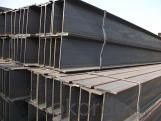
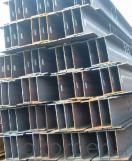
- Q:How do Steel H-Beams contribute to the overall indoor air quality of a building?
- Steel H-Beams do not directly contribute to the overall indoor air quality of a building. Indoor air quality is primarily influenced by factors such as ventilation systems, building materials, and maintenance practices. However, steel H-Beams can indirectly contribute to better indoor air quality by providing structural integrity to the building. These beams are often used in load-bearing applications and can support the weight of the structure, reducing the risk of structural damage or collapse. This can help prevent the entry of outdoor pollutants such as allergens, dust, and moisture, which could potentially degrade indoor air quality. Additionally, steel H-Beams are known for their durability and resistance to moisture, mold, and pests. Their non-porous surface makes it difficult for mold to grow, reducing the chances of mold spores being released into the air. This can help maintain a healthy indoor environment. It is important to note that while steel H-Beams may have some indirect benefits for indoor air quality, other factors such as proper ventilation, use of low-emission building materials, and regular maintenance should be considered to ensure optimal indoor air quality in a building.
- Q:What are the main parts of hot-rolled H steel? What kind of project is required to use H steel, and what kind of customer base is best to find when selling H steel?
- Laiwu actively developed with fire resistance, weather resistance, seismic series of H type steel construction, the advanced international standards of H steel, high strength cold rolling H steel varieties; development of light thin, unequal and unequal thickness profile of H steel; the development of railway vehicles with H transmission towers, weathering steel tower structure with H steel, H steel used for offshore oil platform and other products. Comprehensively upgrade the existing products of H steel.
- Q:How do steel H-beams contribute to the overall sustainability of a transportation hub?
- Steel H-beams contribute to the overall sustainability of a transportation hub in several ways. Firstly, steel H-beams are known for their structural strength and durability, making them an ideal choice for constructing large-scale transportation hubs. Due to their high strength-to-weight ratio, H-beams require fewer materials to achieve the same level of structural support, resulting in reduced resource consumption. This not only helps to conserve natural resources but also minimizes the environmental impact associated with the extraction, manufacturing, and transportation of construction materials. Furthermore, steel H-beams are recyclable, meaning that they can be repurposed or reused at the end of their lifespan. This attribute aligns with the principles of a circular economy, which aims to minimize waste and maximize resource efficiency. By incorporating recyclable materials like steel H-beams into the construction of transportation hubs, we can reduce the amount of construction waste sent to landfills and promote a more sustainable approach to infrastructure development. In addition to their strength and recyclability, steel H-beams also contribute to the sustainability of transportation hubs through their ability to withstand extreme weather conditions. These beams offer excellent resistance to forces such as high winds, earthquakes, and heavy loads, thereby ensuring the long-term stability and safety of the transportation hub. This resilience reduces the need for frequent repairs or replacements, saving both time and resources in the long run. Lastly, steel H-beams can be prefabricated offsite, allowing for efficient construction processes and minimizing disruption to the surrounding environment. Prefabrication reduces construction time, energy consumption, and waste generation, all of which contribute to the overall sustainability of the transportation hub. In conclusion, steel H-beams play a vital role in enhancing the overall sustainability of a transportation hub. Their strength, durability, recyclability, resistance to extreme weather, and ability to be prefabricated contribute to reducing resource consumption, promoting a circular economy, minimizing waste, and ensuring long-term stability. By incorporating steel H-beams into the design and construction of transportation hubs, we can create more sustainable and resilient infrastructure for the future.
- Q:Can steel H-beams be used in the construction of telecommunications infrastructure?
- Yes, steel H-beams can be used in the construction of telecommunications infrastructure. H-beams are commonly used in construction due to their high strength-to-weight ratio, which makes them an ideal choice for supporting heavy loads. They provide excellent structural integrity and stability, making them suitable for various applications, including telecommunications towers, antennas, and equipment shelters. Steel H-beams can withstand extreme weather conditions and provide the necessary support for the installation and maintenance of telecommunications equipment. Additionally, they can be easily fabricated and assembled, allowing for efficient construction and flexibility in design. Overall, steel H-beams are a reliable and durable option for constructing telecommunications infrastructure.
- Q:How do you calculate the shear center of steel H-beams?
- To calculate the shear center of steel H-beams, you need to consider the geometry and the cross-sectional properties of the beam. The shear center is the point on the beam where the applied shear force does not cause any twisting or torsional deformation. Here's a step-by-step process to calculate the shear center: 1. Determine the cross-sectional dimensions of the H-beam, including the flange width, flange thickness, web depth, and web thickness. These dimensions are crucial in understanding the beam's geometry. 2. Identify the centroid of the cross-section, which is the point that represents the average location of the area. It can be found using geometric formulas or numerical integration if the cross-section is complex. 3. Calculate the moment of inertia of the cross-section about both the x-axis and the y-axis. These values represent the resistance of the beam to bending about the respective axes. 4. Determine the shear areas for both the top and bottom flanges. The shear area is the portion of the cross-section that resists shear forces. It can be calculated by multiplying the flange thickness by the distance from the centroid to the top or bottom surface of the flange. 5. Calculate the shear center coordinate. This is done by dividing the product of the shear areas and their respective distances from the centroid by the sum of the shear areas. The shear center coordinate represents the location along the beam's neutral axis where the shear force is effectively applied without inducing torsional deformation. It's important to note that calculating the shear center may require advanced mathematical techniques, especially for complex cross-sections. In such cases, computer software and finite element analysis can be utilized to obtain accurate results. Additionally, it is advisable to consult relevant design codes, such as the AISC Steel Construction Manual, for specific guidance and equations related to H-beam shear center calculations.
- Q:Are steel H-beams suitable for use in the construction of entertainment venues or stadiums?
- Yes, steel H-beams are suitable for use in the construction of entertainment venues or stadiums. Steel H-beams are known for their high strength-to-weight ratio, making them ideal for supporting heavy loads and providing structural stability. They can effectively withstand the dynamic forces and vibrations experienced in entertainment venues or stadiums, ensuring the safety and durability of the structure. Additionally, steel H-beams allow for flexible design options and can be easily customized to meet specific construction requirements, making them a popular choice in the industry.
- Q:Can steel H-beams be used in mezzanine or elevated flooring systems?
- Yes, steel H-beams can be used in mezzanine or elevated flooring systems. Steel H-beams are often used in construction due to their high strength and load-bearing capacity. They provide structural support and stability, making them suitable for creating elevated flooring systems such as mezzanines. The H shape of the beam helps distribute the weight evenly, allowing for larger spans and increased floor space. Additionally, steel H-beams can be easily connected and integrated into the overall structure, making them a popular choice for mezzanine and elevated flooring systems.
- Q:How do steel H-beams perform in terms of impact resistance?
- Steel H-beams are known for their excellent impact resistance. The unique H-shaped cross-section provides a strong and rigid structure that can withstand heavy loads and impacts. This makes them highly suitable for applications where impact resistance is crucial, such as in the construction industry for supporting structures and bridges.
- Q:How do steel H-beams contribute to green roof design?
- Steel H-beams play a crucial role in green roof design by providing structural support and facilitating the integration of various green roof components. These beams act as the backbone of the green roof system, ensuring the stability and durability of the entire structure. One of the main benefits of using steel H-beams is their strength and load-bearing capacity. Green roofs, especially those with extensive vegetation and additional features like water collection systems or rooftop gardens, can be quite heavy. Steel H-beams are capable of withstanding the weight of these elements and distributing it evenly, preventing any structural damage or collapse. Furthermore, steel H-beams allow for flexibility in design. They can be customized to fit the specific dimensions and layout of the green roof, enabling architects and engineers to create unique and innovative structures. This versatility is essential for accommodating various green roof designs, whether it's a small residential building or a large commercial complex. In addition to structural support, steel H-beams contribute to the sustainability of green roofs by being a recyclable material. Steel is one of the most recycled materials globally, making it an environmentally friendly choice. By using steel H-beams in green roof construction, we can reduce the demand for new steel production, conserve resources, and minimize the carbon footprint associated with manufacturing processes. Moreover, steel H-beams are known for their durability and longevity. They can withstand harsh weather conditions, extreme temperatures, and exposure to UV rays without significant degradation. This durability ensures that the green roof structure will last for a long time, reducing the need for frequent repairs or replacements. By reducing the maintenance requirements, steel H-beams contribute to the overall sustainability of the green roof system. In conclusion, steel H-beams are indispensable for green roof design as they provide the necessary strength and stability, enable flexible design options, and contribute to sustainability by being recyclable and durable. These beams ensure the longevity of green roofs, allowing for the creation of sustainable and environmentally friendly urban spaces.
- Q:How do steel H-beams perform in terms of deflection?
- Steel H-beams are known for their excellent performance in terms of deflection. Due to their unique shape and structural design, H-beams have high resistance against bending and deflection. The horizontal flanges and vertical web of the H-beam provide superior strength and stiffness, allowing it to withstand heavy loads without significant deflection. Compared to other structural materials like wood or concrete, steel H-beams have a much higher modulus of elasticity. This means that they are less prone to bending and sagging under loads, resulting in minimal deflection. Additionally, the H-beam's wide flanges distribute the load over a larger surface area, further reducing the deflection. Furthermore, steel H-beams are often fabricated using high-quality steel alloys that offer excellent strength-to-weight ratios. This ensures that the beams can support significant loads without excessive deflection. In construction projects where deflection is a critical factor, such as bridges or high-rise buildings, steel H-beams are often the preferred choice due to their superior performance in this regard. However, it is important to note that the deflection of steel H-beams can still occur under extremely heavy loads or when subjected to excessive forces. Proper engineering and structural design, including the selection of the appropriate beam size and reinforcement, are crucial to ensure minimal deflection and maintain structural integrity. In summary, steel H-beams perform exceptionally well in terms of deflection. Their unique shape, high modulus of elasticity, and wide flanges contribute to their superior resistance against bending and sagging. When properly designed and installed, steel H-beams can effectively support heavy loads while exhibiting minimal deflection.
1. Manufacturer Overview |
|
|---|---|
| Location | |
| Year Established | |
| Annual Output Value | |
| Main Markets | |
| Company Certifications | |
2. Manufacturer Certificates |
|
|---|---|
| a) Certification Name | |
| Range | |
| Reference | |
| Validity Period | |
3. Manufacturer Capability |
|
|---|---|
| a)Trade Capacity | |
| Nearest Port | |
| Export Percentage | |
| No.of Employees in Trade Department | |
| Language Spoken: | |
| b)Factory Information | |
| Factory Size: | |
| No. of Production Lines | |
| Contract Manufacturing | |
| Product Price Range | |
Send your message to us
Hot Rolled Structural Steel H Beam SS400
- Loading Port:
- Tianjin
- Payment Terms:
- TT or LC
- Min Order Qty:
- 100 m.t.
- Supply Capability:
- 100000 m.t./month
OKorder Service Pledge
OKorder Financial Service
Similar products
New products
Hot products
Hot Searches
Related keywords
